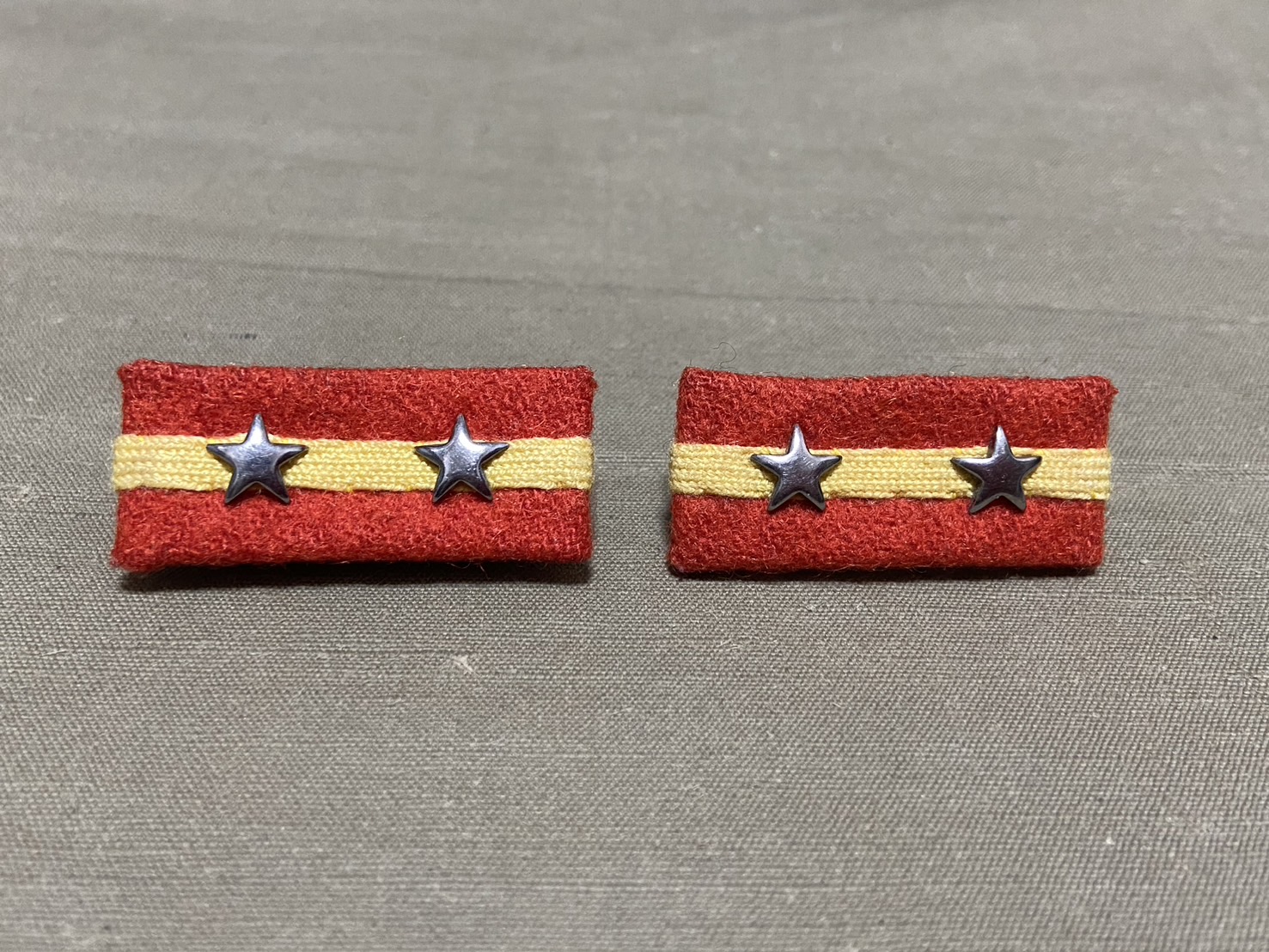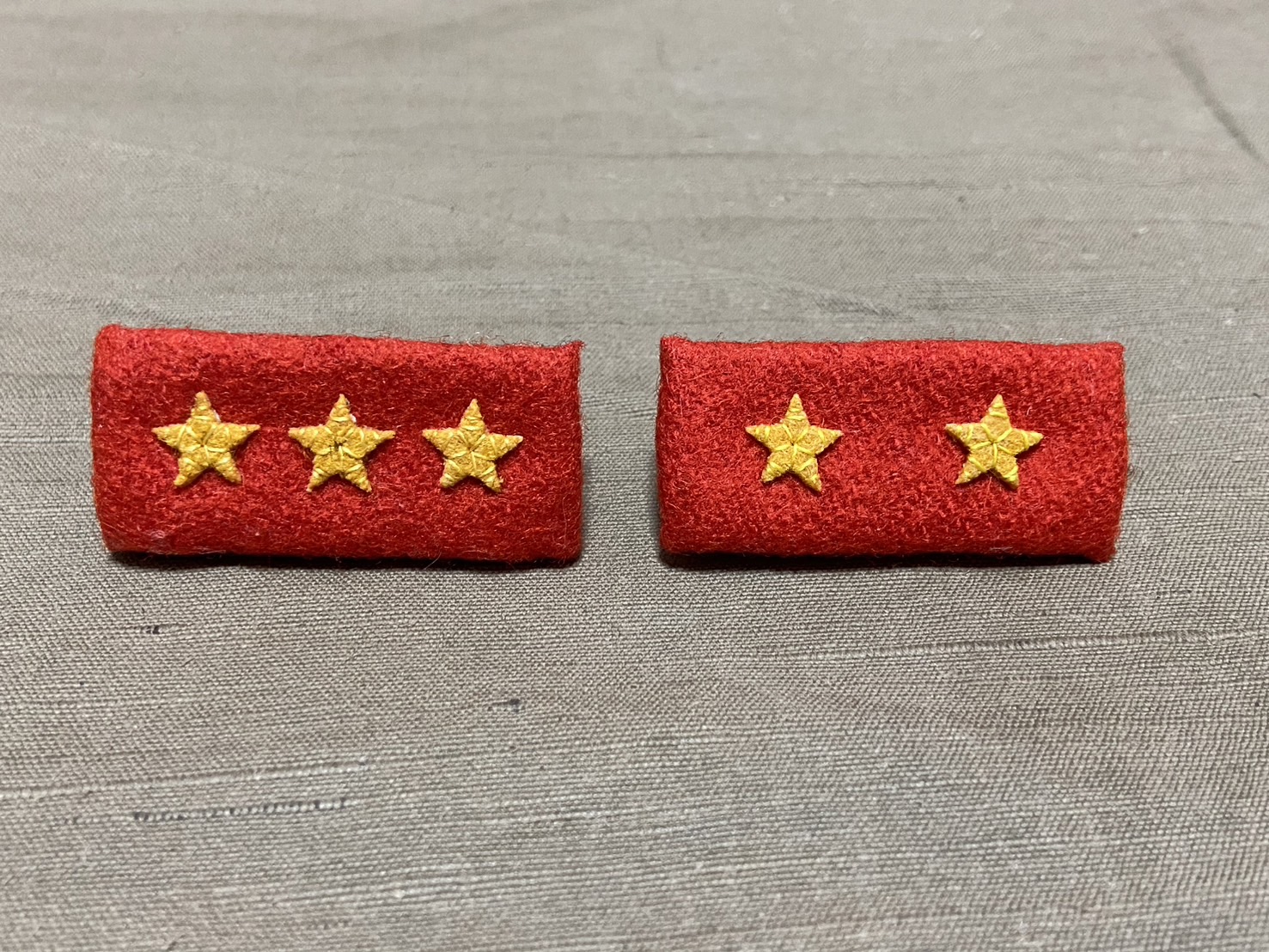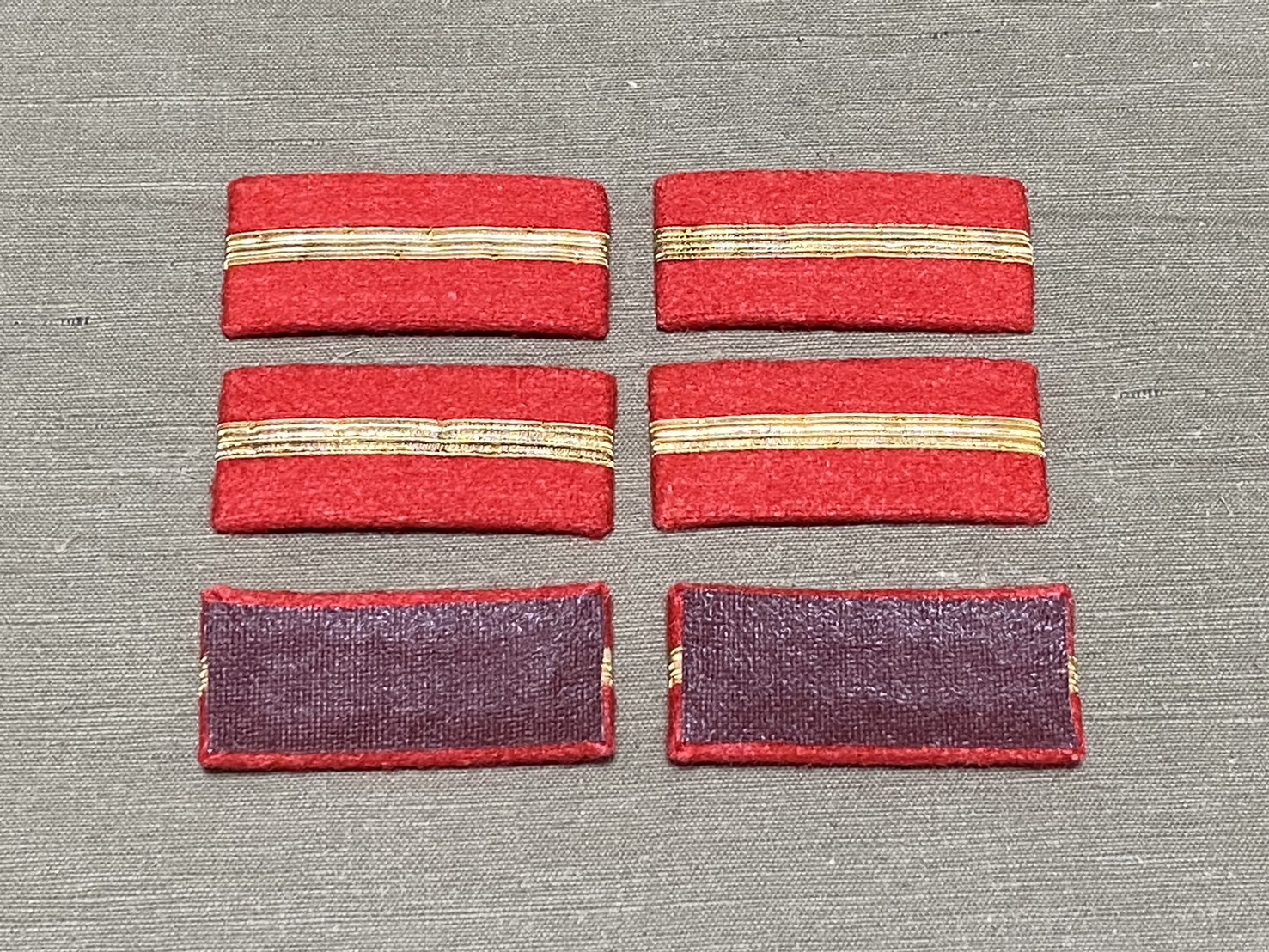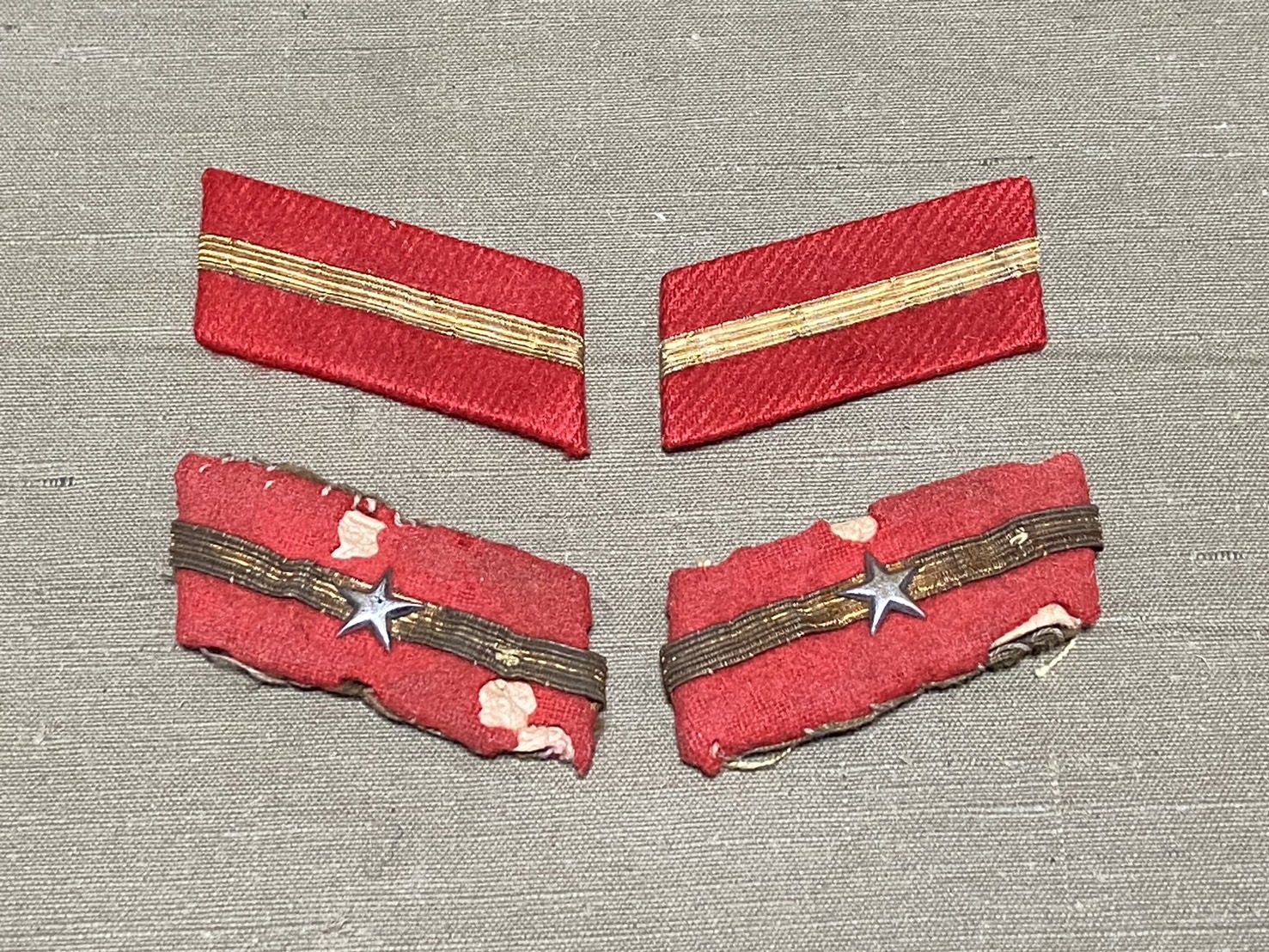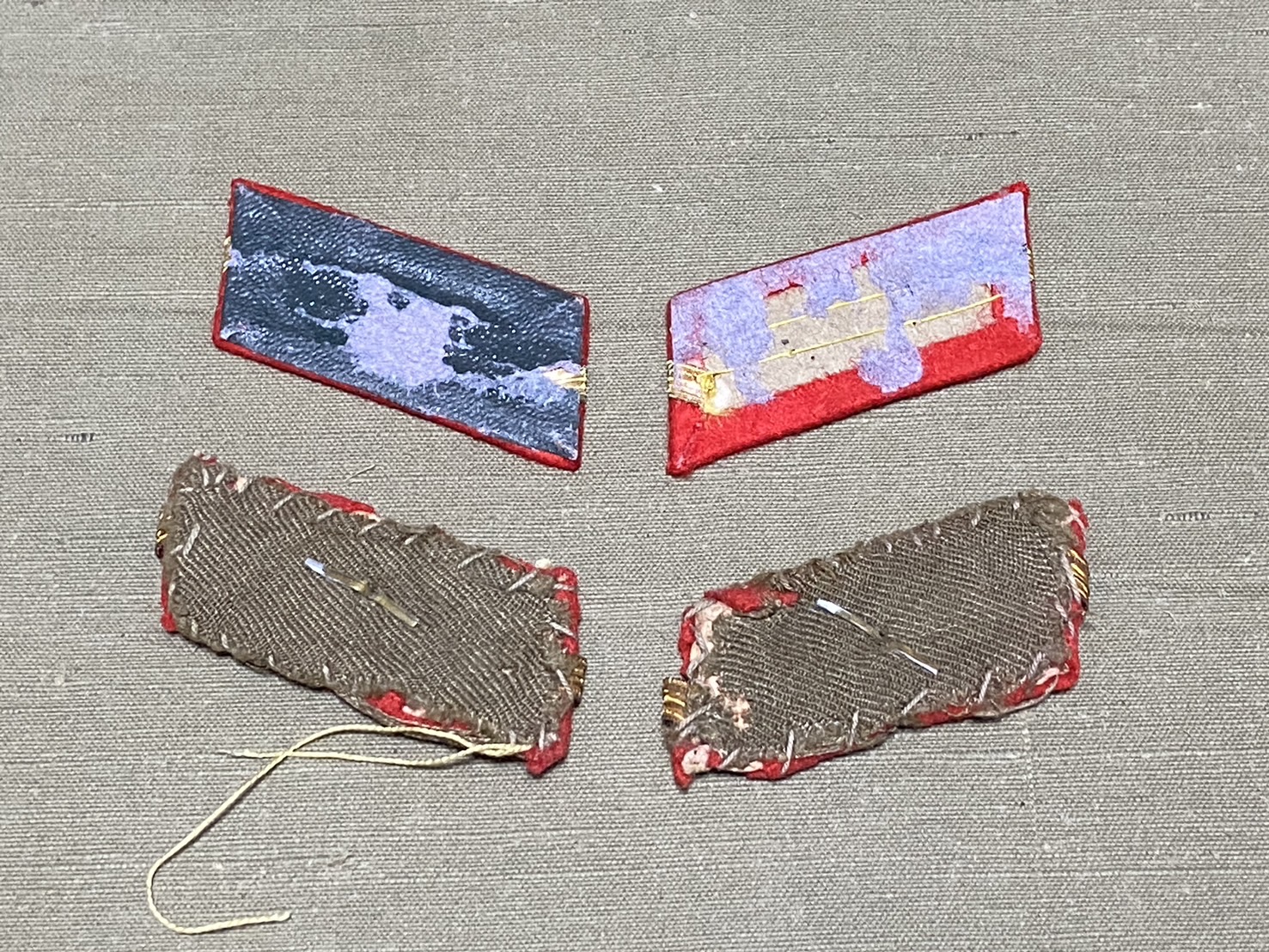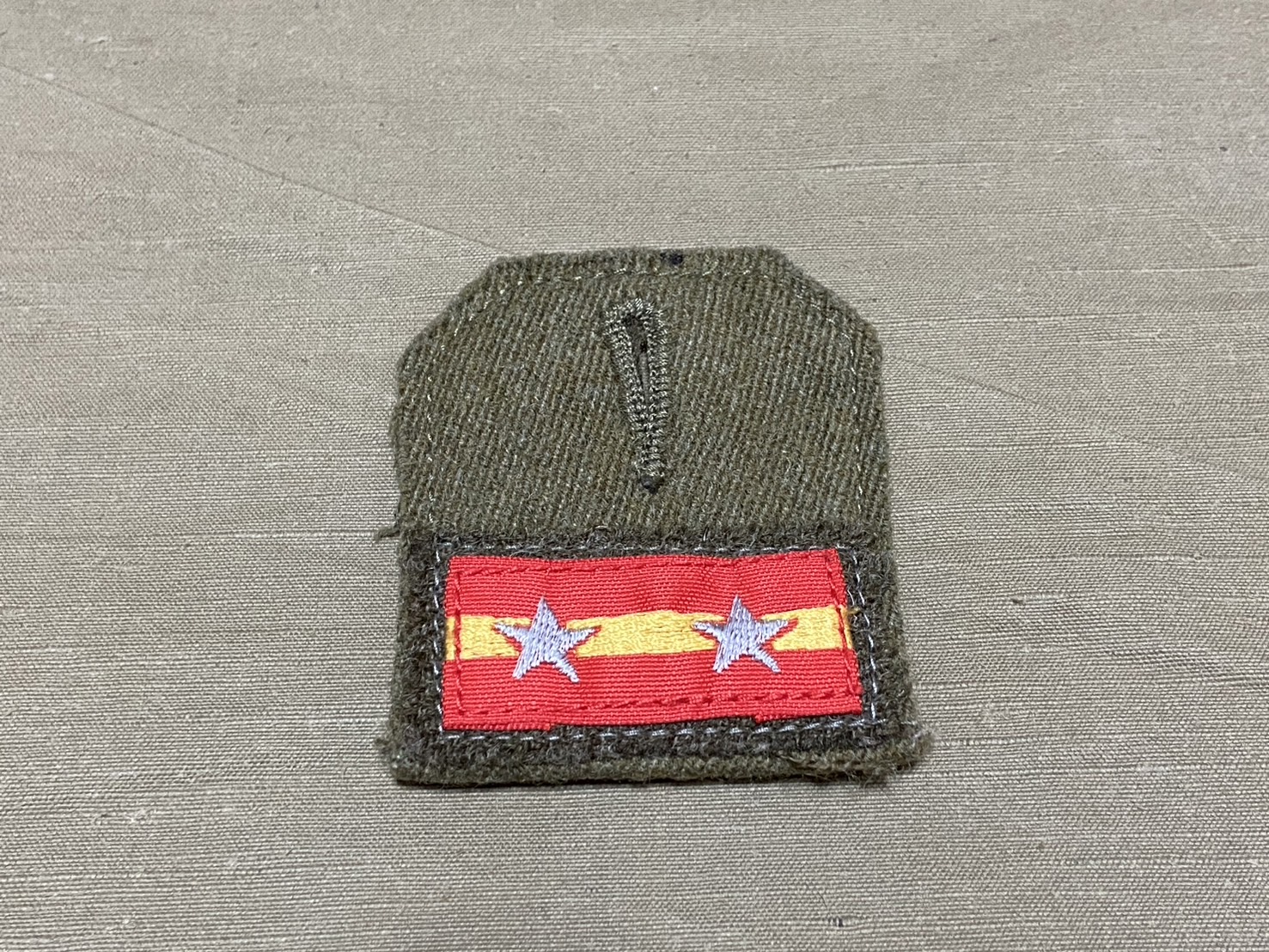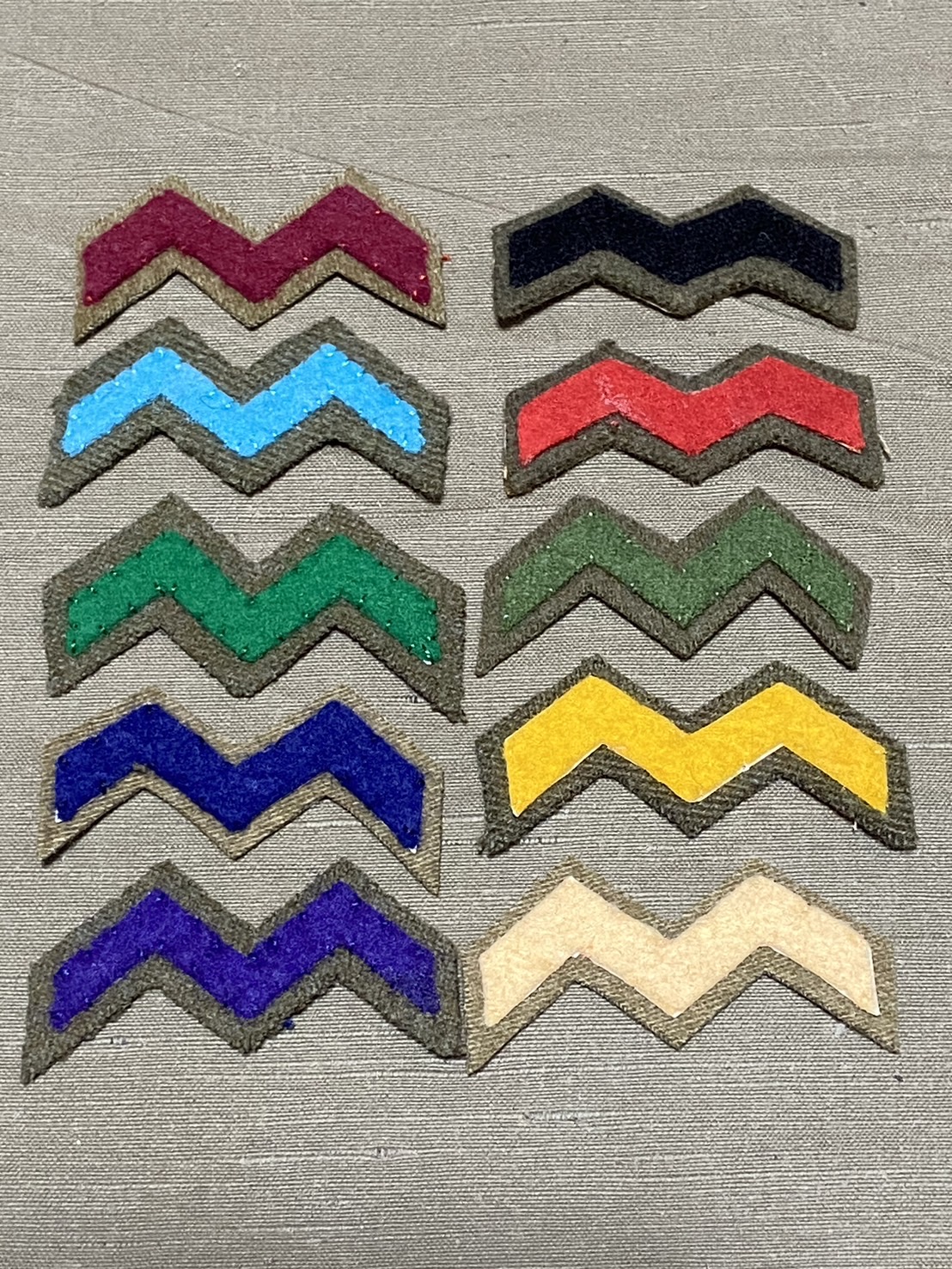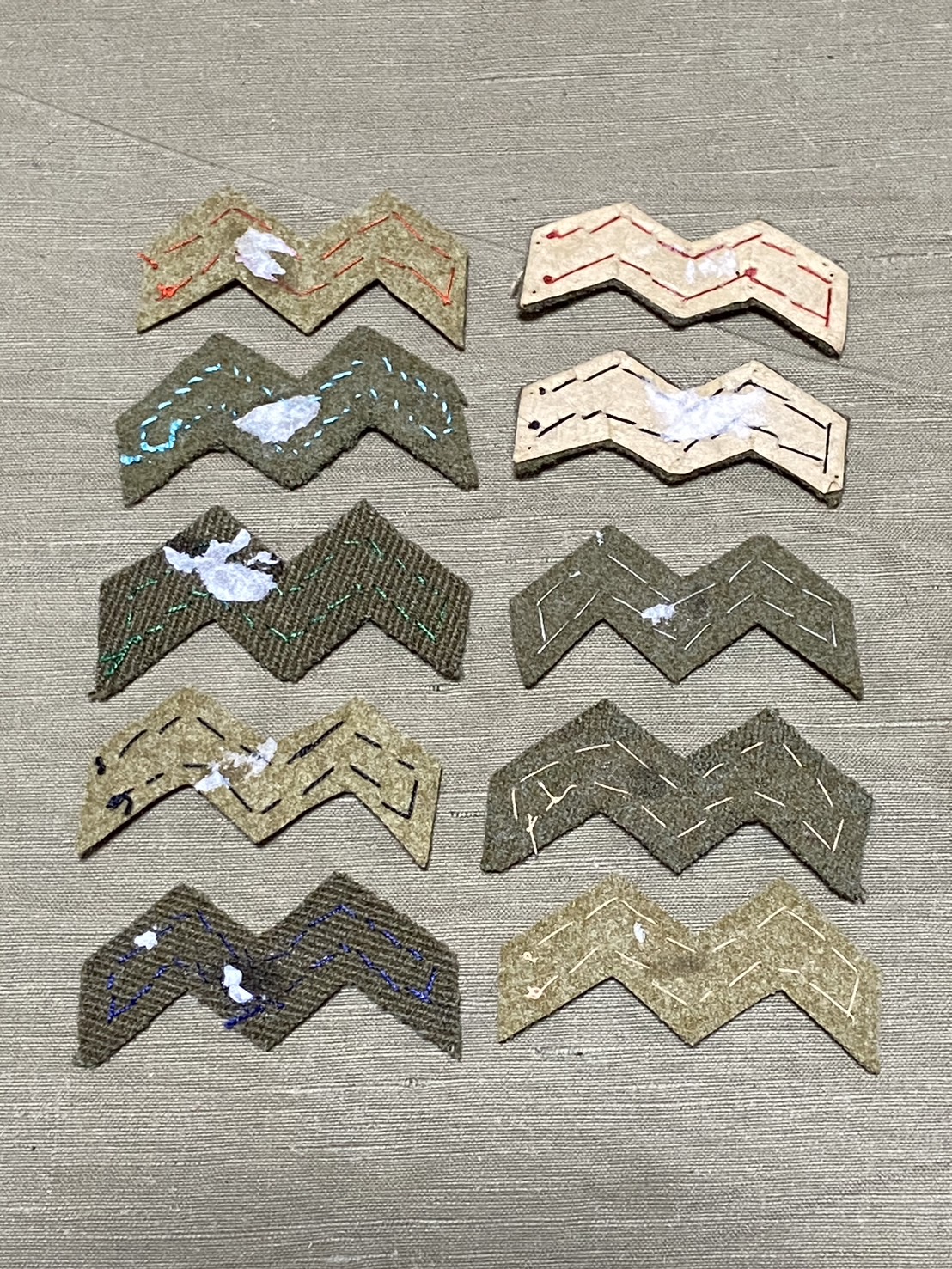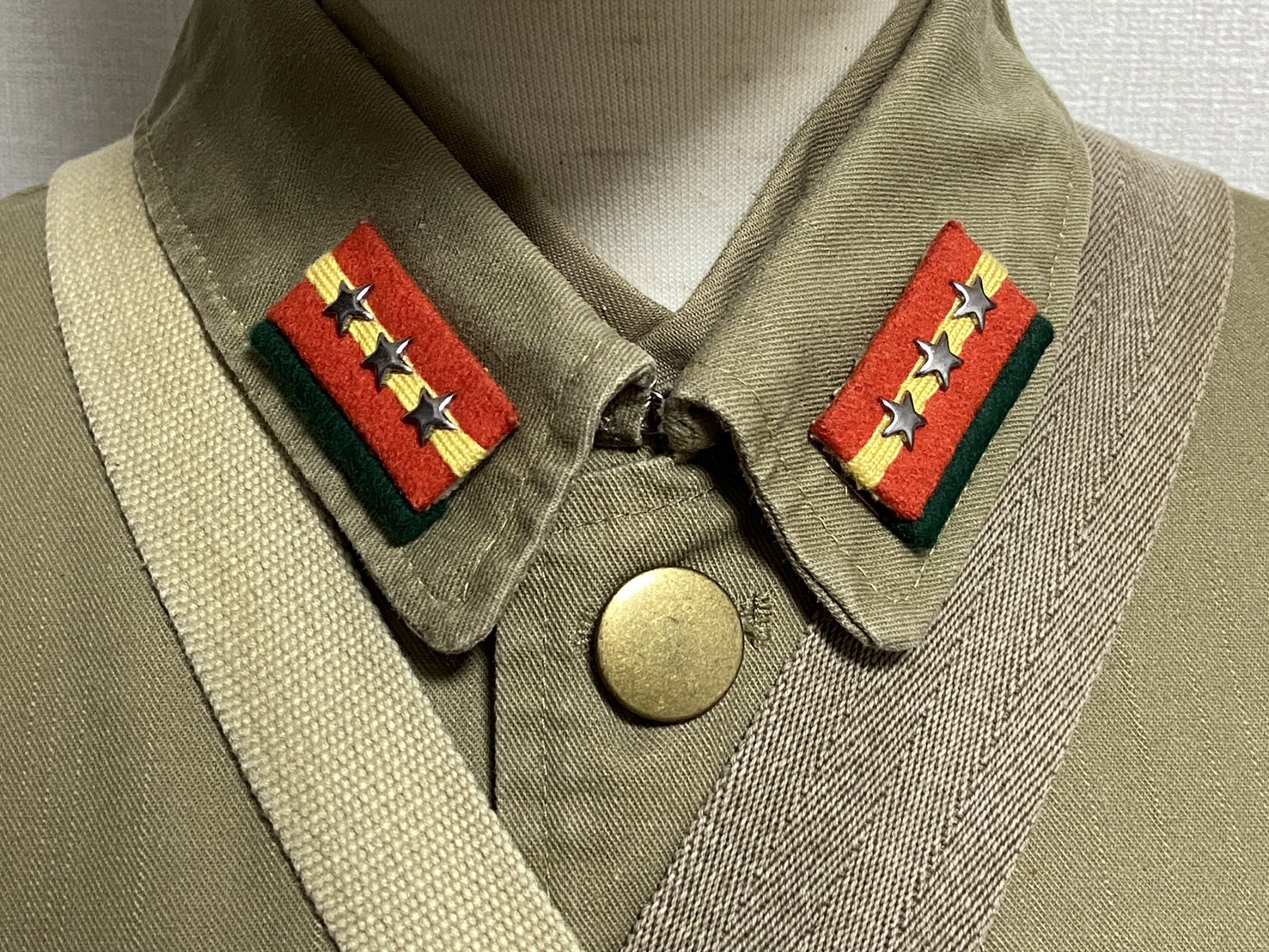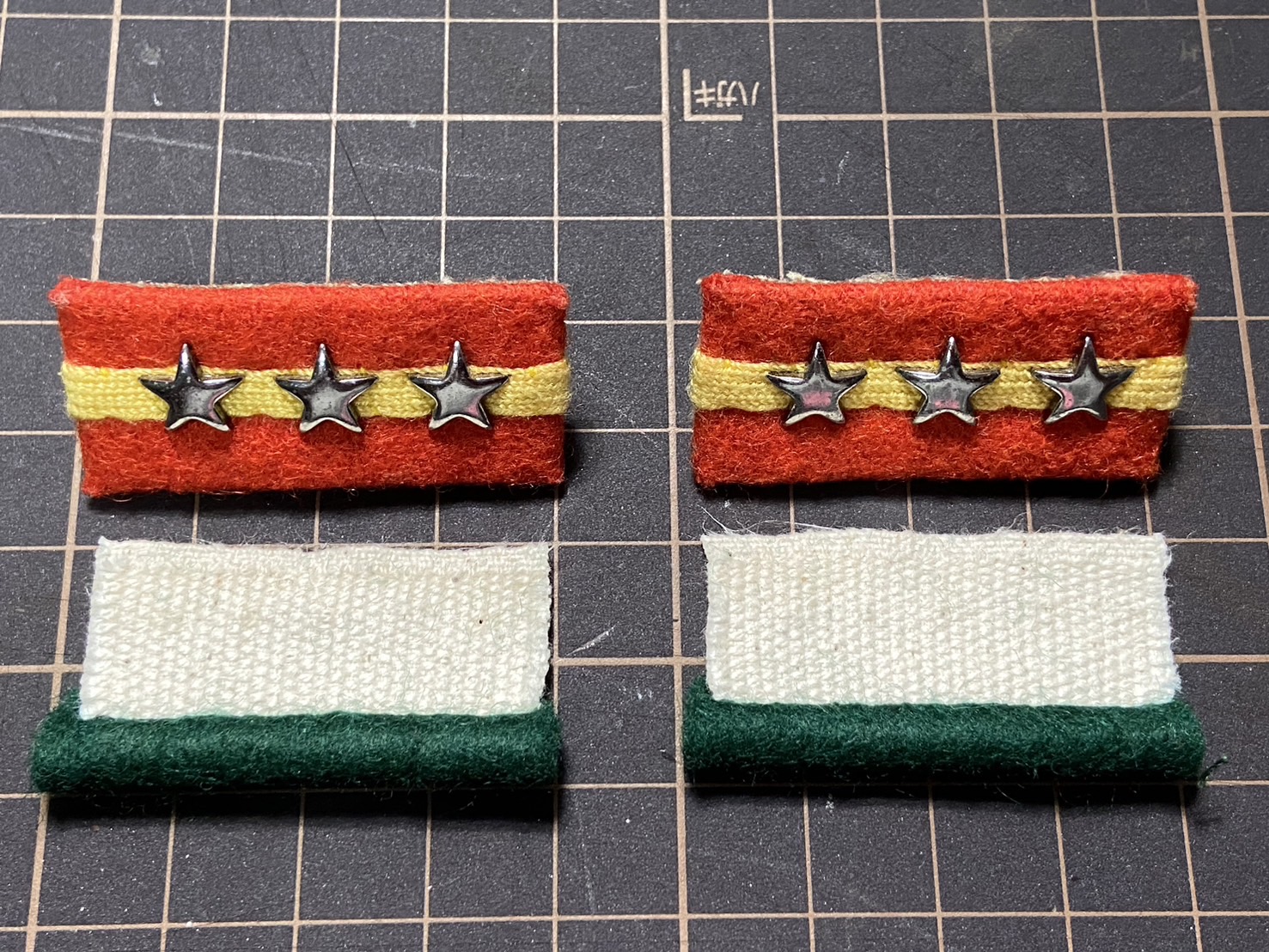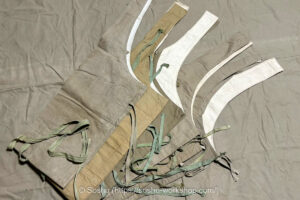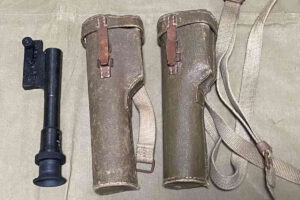This time, I would like to introduce the changes in rank insignias and identification Insignias worn on the Type 98 military uniform established in Showa 13.
When aiming to accurately reproduce past military attire, the specific year and month is an important factor. It is crucial to understand when the new regulations were implemented if one is to wear military attire according to the revised standards; otherwise, it may result in a uniform that does not actually exist.
However, in the case of wearing military attire based on older regulations, it is acceptable even if it is after the new regulations have come into effect. The imperial decree regarding the amendments states, “Uniforms based on previous regulations may still be used for the time being.” Additionally, in frontline situations, updates may not occur immediately. Moreover, as long as there is stock based on the old regulations, it can continue to be used until it runs out.
- 1 Changes in Collar Insignias and Identification Insignias of the Folded Collar Military Uniform
- 1.1 Showa 13, Imperial Decree No. 392, Amendment of Army Uniform Regulations1
- 1.2 Showa 15, Imperial Decree No. 585, Amendment to the Army Uniform Regulations3
- 1.3 Showa 15, Army Secret No. 19056
- 1.4 Showa 18, Imperial Decree No. 774, Amendment to the Army Uniform Regulations7
- 1.5 Mixing of the Type 98 Collar Insignias with the Type 5 Military Uniform
- 2 Collar Insignias
- 3 Collar Identification Insignia
- 4 Summary
- 5 Footnote
Changes in Collar Insignias and Identification Insignias of the Folded Collar Military Uniform
I will briefly summarize the changes in collar insignias used since the introduction of the folded collar military uniform. In Showa 13 (1938), the folded collar Type 98 military uniform was established, and from that point, insignias began to indicate rank. Furthermore, during the era of the standing collar military uniform, the colors representing different branches and units were indicated by the collar insignias. However, with the introduction of the folded collar military uniform, these colors were represented using separate identification insignia.
While these changes have also been documented in publications by earlier scholars, I will refrain from quoting them and will instead verify the information again using primary sources.
Showa 13, Imperial Decree No. 392, Amendment of Army Uniform Regulations1
Promulgated on May 31, Showa 13, and effective on the same day.
- Uniform Regulations for Officers and Warrant Officers
- Collar Insignias
- Specifications
- Base Material: Scarlet felt
- Stripe Details: Both edges in gold thread embroidery or plain-woven yellow silk thread; center stripe in plain-woven gold thread or yellow silk thread
- Star Insignias: Silver metal, diameter: ? mm2
- Design Dimensions
- Width: 40 mm, Height: 18 mm
- Adjust the angle as appropriate to fit the collar shape
- Specifications
- Chest Insignia (Excluding Generals)
- Specifications
- Base Material: Designated color felt
- Specifications
- Collar Insignias
- Uniform Regulations for Non-Commissioned Officers and Soldiers
- Collar Insignias
- Specifications
- Base Material: Scarlet felt
- Stripe Details: Plain-woven yellow silk thread or gold thread; however, soldiers do not have stripes
- Star Insignias: Silver metal for non-commissioned officers, yellow felt for soldiers, diameter: 9 mm
- Design Dimensions
- Width: 40 mm, Height: 18 mm
- Specifications
- Chest Insignia
- Specifications
- Base Material: Designated color felt with a brownish felt lining attached
- Specifications
- Collar Insignias
The first thing I found from examining primary sources is that, according to uniform regulations, there was no issue with officers using yellow stripes on their collar insignias or with non-commissioned officers using gold stripes. While the government-issued collar insignias for non-commissioned officers featured yellow stripes, it was permissible within regulations for them to use privately owned insignias with gold stripes.
Regarding the shape of the collar insignias, I had assumed that the insignias for officers and warrant officers became a parallelogram in a later amendment. However, in Showa 13, the diagram already shows a parallelogram, with a note allowing the angle to be adjusted to match the shape of the collar. For non-commissioned officers and soldiers, the diagram shows a rectangular insignias, without any mention of adjusting the angle.
Showa 15, Imperial Decree No. 585, Amendment to the Army Uniform Regulations3
Promulgated on September 13, Showa 15, and effective on September 15, Showa 15.
- A new rank, Heicho (Lance Corporal), was established between Corporal and Superior Private.
- The designated colored chest Insignia shaped like an inverted ‘W’ worn on the right chest was revised: it was discontinued for the military branches4 and remained only for the departments5.
- For the Military Police Corps, a special insignias was established to be worn beside the rank insignias on the collar.
- This means that the Military Police would wear the special insignias instead of the chest insignia shaped like an inverted ‘W’.
Showa 15, Army Secret No. 19056
On September 14, Showa 15, a directive was issued concerning collar insignias, including commonly referred numbers (unit numbers) and special insignias to be worn on the collar. As a result, the Kanto Army, units stationed outside the Empire, and mobilized units outside the Empire were instructed not to wear collar insignias (with the exception of the special insignias for the Independent Infantry Garrison). With the exception of officer candidates, executive candidates, and military police insignias, the collar insignias was abolished.
Showa 18, Imperial Decree No. 774, Amendment to the Army Uniform Regulations7
Promulgated on October 12, Showa 18, and effective on the same day. The establishment of the Type 3 military uniform is also based on this imperial decree.
- The chest insignia shaped like an inverted ‘W’ was abolished and replaced with a 4 mm-wide identification insignias to be worn below the collar insignias.
- The arrangement of stars on the collar insignia was changed from centered to positioned closer to the center of the body.
- The diameter of the star insignias for officers and non-commissioned officers was set at 11 mm, while it remained 9 mm for soldiers.
- The size of the collar insignias for officers was adjusted according to rank:
- Lieutenant: Width 45 mm, Height 20 mm
- Captain: Width 45 mm, Height 25 mm
- General: Width 45 mm, Height 30 mm
Mixing of the Type 98 Collar Insignias with the Type 5 Military Uniform
When looking at photographs from that time, it is not uncommon to find instances of Type 98 collar insignias being worn on the collar of the Type 5 military uniform. I also have several such photos.
There are historical documents that acknowledge the mixing of insignias8. According to these, it was permissible to remove the shoulder straps and collar insignias of the Type 5 uniform and attach the Type 98 collar insignias and chest insignia shaped like an inverted ‘W’ to the right without modifying the collar itself. Additionally, it was advised to continue using the older Type 5 uniform for as long as possible to conserve resources. In the Imperial Japanese Army, outdated uniforms were referred to as “三装” (San-so, the third uniform)9 and were used as work uniforms for exercises and tasks. The snapshots taken after exercises showing the Type 5 military uniform with Type 98 collar insignias likely depict uniforms that had been repurposed for such use.
This practice applied to officers and warrant officers as well; they were instructed to continue using the Type 5 uniform for as long as it lasted without needing to acquire new uniforms solely to conform to the new regulations. Due to these circumstances, many Type 5 uniforms for officers were modified to become Type 98 uniforms. The only actual officer uniform I possess also shows signs of being modified from Type 5 to Type 98.
Interestingly, there were officers who deliberately had their uniforms newly tailored in the old style. A directive stated, “Since the main purpose is to conserve clothing resources, modifications due to various personal reasons, such as issues with the collar or soiling, or necessary new tailoring due to unavoidable circumstances, are acceptable.
Collar Insignias
Now, I will introduce the Type 98 collar insignias for non-commissioned officers and soldiers. The term ‘Type 98 collar insignias’ can indeed be found in the primary historical documents from that time.
Government-issued Collar Insignias
I unfortunately do not possess any authentic government-issued collar insignias. I realized that I have primarily collected private insignias instead.
What I will introduce below is a replica of the government-issued collar insignias made by the Nori. The standard collar insignias for non-commissioned officers and soldiers is rectangular in shape, and the stripe representing non-commissioned officers is made of yellow tape.
These are an authentic item I purchased, consisting of three sets of Lance Corporal collar insignias. They are in excellent condition, likely unused dead stock. Private collar insignias like this were typically sold based on the Lance Corporals insignias, and individuals would attach stars according to their own rank.
Private Collar Insignias
While there are many primarily for non-commissioned officers, there are also private collar insignias designed to resemble those for officers. Originally, private insignias were intended for use by reserve soldiers, but it seems that active-duty military personnel also used them in their units.
The first type maintains a rectangular shape and uses yellow tape with gold thread, similar to that of officers. This was confirmed in the Showa 13 decree No. 392, which allowed non-commissioned officers to use gold thread.
Next, I will introduce insignias that uses gold thread and has a parallelogram shape similar to that of officer insignias. However, the use of a parallelogram shape is not stipulated for non-commissioned officers and soldiers, so it may have been prohibited by some units due to its similarity to officer insignias when viewed from a distance. That said, it is possible that this was tolerated due to the material shortages at the time.
The photos below show authentic items, and if you look at the back of the Corporal collar insignia, you will notice that the pin for the star insignia is not concealed by the backing; it is exposed. This is another piece of evidence suggesting that stars were added later to the Lance Corporals insignia. I have also seen other private collar insignia on Yahoo Auction where the feet of the stars were protruding in a similar manner.
By the way, this worn-out sergeant’s insignia was found in the pocket of the authentic Type 98 summer uniform that was introduced in this article before.
I don’t own any of these, but I have come across the following types of private-purchase collar insignia:
- A parallelogram-shaped insignia for superior privates.
- An embroidered insignia with a metal star added (a lance corporal insignia with an attached star).
- A rectangular insignia with proportions differing from the standard-issue items (likely related to the increase in size of officer insignia following Imperial Decree No. 774 in Showa 18).”
Information about private collar insignia is scarce online, but they can be spotted occasionally in auctions and don’t usually fetch high prices, suggesting they aren’t particularly rare.
In any case, as a military uniform enthusiast, adding a touch of flair with gold lines or parallelogram-shaped private-purchase collar insignia feels like a stylish detail worth trying out.
Woven Collar Insignia
I was searching through materials at the Japan Center for Asian Historical Records regarding the establishment of the woven collar insignia, but I couldn’t locate it within the revisions to the Army uniform regulations.
In a document titled “Specifications for Army Clothing and Equipment”, I discovered the “Specification for Experimental Woven Collar Insignia”10. It notes that the insignia was established on May 26, Showa 14, and revised on February 24, Showa 17. In another source, “Army Directive No. 65”11 of Showa 18 contains the statement: “Collar insignia (woven insignia representing the color of the base material, line insignia, and stars) may be affixed to both collar areas.
The introduction of woven collar insignia seems to have occurred around the mid to late Showa 17 to Showa 18.
The introduction of woven collar insignia seems to have occurred around the mid to late Showa 17 to Showa 18.
I have a replica made by Nakata Shōten, which is sewn onto a base so it can be attached to buttons on items like the tropics shirt.
Collar Identification Insignia
The identification insignia is used to display the designated colors of each military branch and department. It was established as a chest Insignia when the Type 98 uniform was enacted in Showa 13. By Showa 15, it was abolished for the military branches and was worn only by the various departments. Subsequently, from Showa 18, it became insignias worn below the collar insignias.
Chest Insignia
Due to its shape, it is often referred to as the “山形胸章” (Yamagata Mune-shō / Mountain shaped chest insignia).
The following is something I purchased from Yahoo Auctions, claimed to be an authentic piece, though its authenticity is uncertain. Judging by the condition of the back, it appears to have aged reasonably well. This particular piece is for non-commissioned officers and soldiers, featuring a brownish-brown woolen backing. It seems that remnants of old field wool leggings and other military uniforms have been repurposed for its construction.
Identification Insignia
Here is a replica I created. Since it was established towards the end of the war, there were not many specifications, and only the width of the lines was specified, so detailed specifications are not well known. I’ve heard that it was said to have been made by cutting the collar insigniafrom the Type 5 military uniform to make it narrower.
Summary
I originally started writing this article to introduce private insignia for non-commissioned officers and soldiers, but as I checked the descriptions of the Army uniform regulations, the theme expanded significantly. There are few comprehensive references on the evolution of rank insignia, and it requires checking various historical documents for confirmation, so I organized this information as a personal reminder. I hope it will also be helpful for everyone involved in military uniform activities.
Footnote
- “Original signed document, Showa 13, Imperial Decree No. 392, Amendment of Army Uniform Regulations“, JACAR (Japan Center for Asian Historical Records) Ref. A03022207000; Original signed document, Showa 13, Imperial Decree No. 392, Amendment of Army Uniform Regulations (National Archives of Japan). ↩︎
- “In Comprehensive Illustrated Encyclopedia of Army and Navy Uniforms” (edited by Tsunenobu Kitamura, 1996, Kokusho Kankokai), the diameter is listed as 8 mm. However, it does not seem to be specified in Imperial Decree No. 392… ↩︎
- “Original signed document, Showa 15, Imperial Decree No. 585, Amendment to the Army Uniform Regulations“, JACAR (Japan Center for Asian Historical Records) Ref. A03022498500; Original signed document, Showa 15, Imperial Decree No. 585, Amendment to the Army Uniform Regulations (National Archives of Japan). ↩︎
- Military Police Corps, Infantry Corps, Cavalry Corps, Artillery Corps, Engineer Corps, Aviation Corps, Supply Corps ↩︎
- As of Showa 13, there were four departments: the Accountant’s Department, Medical Department, Veterinary Department, and Military Band Department. In Showa 15, the Technical Department was added, and in Showa 17, the Legal Affairs Department was established. ↩︎
- “Regarding the official insignias for the collar based on the Army Uniform Regulations, Article 5, Army Order No. 8 of Showa 5”, JACAR (Japan Center for Asian Historical Records) Ref. C01007786300; Volume 1 of the Correspondence Collection (Military Secret) Showa 15 (National Defense Medical College) ↩︎
- “Original signed document, Showa 18, Imperial Decree No. 774, Regarding the Amendment to the Army Uniform Regulations“, JACAR (Japan Center for Asian Historical Records) Ref. A03022866700; Original signed document, Showa 18, Imperial Decree No. 774, Regarding the Amendment to the Army Uniform Regulations (National Archives of Japan). ↩︎
- “Regarding the Mixing of Official Insignias as per Item 3 of the Army Uniform Regulations Appendix”, JACAR (Japan Center for Asian Historical Records) Ref. C01001561500; Permanent Documents Compilation, Volume 1, Showa 13 (National Defense Medical College). ↩︎
- “一装” (Issou, the first uniform) was issued for deployment or inspection, “二装” (Ni-so, the second uniform) for outings, and “三装” (San-so, the third uniform) for everyday wear. The “三装” were further divided into “甲” (Kō, A) and “乙” (Otsu, B) types, where “三装の甲” was for guard duty and ceremonial purposes within the unit, while “三装の乙” was true casual wear. The “一装” was usually stored by the unit and was not issued; instead, one “二装” uniform, one “三装の甲” uniform, and two “三装の乙” uniforms were typically issued (from “A Collection of Army Terminology Anecdotes” by Hiroshi Hiruma, 1985, Kōjinsha). ↩︎
- “Army Clothing Specifications Collection, Vol. 2, Section 2 – Military Clothing Materials, Chapter 5 – Miscellaneous Items“ JACAR (Japan Center for Asian Historical Records) Ref. C14010285000, Army Clothing Specifications Collection, Vol. 2 (October Showa 17, 1942, National Institute for Defense Studies) ↩︎
- “Amendment to Army Directive No. 44 of Showa 18 as Noted on the Left“ JACAR (Japan Center for Asian Historical Records) Ref. C01007837800, Army Secret Documents and Other Compilations, February to November Showa 18 (National Institute for Defense Studies) ↩︎
